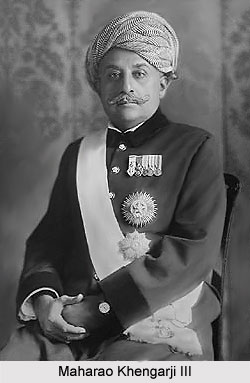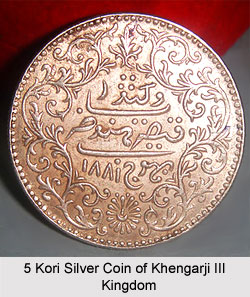 Khengarji III or Khengarji Bawa, officially known as Maharajadhiraj Mirza Maharao Sri Sir Khengarji III Sawai Bahadur, GCSI, GCIE, KIH, was one of the longest ruling and a progressive ruler or Maharao of the princely state of Cutch, which is currently known as Kutch district in the state of Gujarat in western India. He ruled over the territory from the year 1875 to 1942. He was born on 23rd August 1866 to father Maharao Shri Pragmalji II and belonged to the Jadeja clan of Rajputs. After the death of his father on 19th December 1875, Khengarji III succeeded him and ascended the royal throne on 3 January 1876. As he was still a minor, Maharao of Cutch ruled under a Council of Regency until he reached the age of majority on 11th August 1884. Later on November 14th 1884, Khengarji III was invested with full ruling powers.
Khengarji III or Khengarji Bawa, officially known as Maharajadhiraj Mirza Maharao Sri Sir Khengarji III Sawai Bahadur, GCSI, GCIE, KIH, was one of the longest ruling and a progressive ruler or Maharao of the princely state of Cutch, which is currently known as Kutch district in the state of Gujarat in western India. He ruled over the territory from the year 1875 to 1942. He was born on 23rd August 1866 to father Maharao Shri Pragmalji II and belonged to the Jadeja clan of Rajputs. After the death of his father on 19th December 1875, Khengarji III succeeded him and ascended the royal throne on 3 January 1876. As he was still a minor, Maharao of Cutch ruled under a Council of Regency until he reached the age of majority on 11th August 1884. Later on November 14th 1884, Khengarji III was invested with full ruling powers.
Rule of Khengarji III
During his reign, which extended over a period of 66 years, Maharao Khengarji III of the princely state of Cutch (Kutch) developed his state for the betterment of his subjects. Moreover he modernized the princely state and led it to the 20th century. During the reign of Queen Victoria, Sir Khengarji was appointed as an aide de camp to the Queen- Empress in her moribund years. The Maharao frequently traveled to Europe and became renowned for maintaining special relations with the members of the ruling houses. Khengarji III attended all of the 3 Durbars held at Delhi in 1877, 1903 and 1911 and was eventually honoured with a local salute of 19 guns. He represented the country at the League of Nations conference held in Geneva in the year 1921.
Khengarji III, the Maharao of the princely state of Cutch, successfully took and implemented various progressive and reformative steps for the advancement of his state. During his rule, several renowned buildings and structures were established and constructed. The Prag Mahal, commissioned by his father Shri Pragmalji II in 1865, was completed under the supervision of Khengarji III in the year 1878. Moreover he also established the Fergusson Museum (now Kutch Museum), which is the oldest museum in Gujarat, in 1877. He also constructed the Vijay Vilas Palace in 1920 and renovated the Suralbhit Jadeshwar Temple, located near Bhuj, in the year 1914. At the request of Rai Bahadur Jagmal Raja Chauhan of Nagor, Khengarji III built the Cutch Castle at Bombay (now Mumbai) during the 1920s. Further more the eminent ruler also commissioned his colossal residence Darya Mahal in Bombay in 1940 and sanctioned the Haji Dargah complex in the Rann.
Apart from these, Maharao Khengarji III introduced a narrow gauge line of Cutch State Railway, which was controlled by the princely state of Cutch. Later railway tracks were laid between Anjar and Tuna Port during 1900 and the first train was started in 1905. Eventually in 1908, the Cutch State Railway lines were extended from Anjar to Bhuj and then to Bhachau, Bhimasar and Kandla. The ruler of Cutch also introduced automobile, electricity and aviation for the betterment of the people and over all society. Sir Khengarji III also supported the establishment of a new port of Kandla in the year 1930.
Several state funded educational institutes and schools were also founded during his reign. Some of the most reputed institutes included Alfred High School, Sanskrit Pathshala and Library in the princely state of Cutch (Kutch). He also constructed a number of public hospitals at Mandvi and Bhuj. During the rule of Khengarji III, inflation was also kept in control.
Personal Life of Khengarji III
Maharao Khengarji III of the princely state of Cutch died at the age of 75.
He was succeeded by Vijayaraji, his son.
Titles of Khengarji III
 Khengarji III held numerous titles and styles through out his reign over the princely state of Cutch. These are discussed below-
Khengarji III held numerous titles and styles through out his reign over the princely state of Cutch. These are discussed below-
* Maharajkumar Shri Khengarji Pragmulji, Yuvraj Sahib of Kutch (1866- 1875)
* His Highness Maharajadhiraj Mirza Maharao Shri Khengarji III Sahib Bahadur, Rao of Kutch (1875- 1877)
* His Highness Maharajadhiraj Mirza Maharao Shri Khengarji III Sahib Bahadur, Rao of Kutch, KIH (1877- 1885)
* His Highness Maharajadhiraj Mirza Maharao Shri Khengarji III Sawai Bahadur, Rao of Kutch, KIH (1885- 1887)
* His Highness Maharajadhiraj Mirza Maharao Shri Sir Khengarji III Sawai Bahadur, Rao of Kutch, GCIE, KIH (1887- 1917)
* His Highness Maharajadhiraj Mirza Maharao Shri Sir Khengarji III Sawai Bahadur, Rao of Kutch, GCSI, GCIE, KIH (1917- 1918)
* His Highness Maharajadhiraj Mirza Maharao Shri Sir Khengarji III Sawai Bahadur, Maharao of Kutch, GCSI, GCIE, KIH (1918- 1929)
* Colonel His Highness Maharajadhiraj Mirza Maharao Shri Sir Khengarji III Sawai Bahadur, Maharao of Kutch, GCSI, GCIE, KIH (1929- 1942)
Honours of Khengarji III
Maharao Khengarji III was honoured several times, which are mentioned as follows-
* Kaiser-i-Hind Gold Medal- KIH (1877)
* Knight Grand Commander of the Order of the Indian Empire- GCIE (1887)
* Queen Victoria Golden Jubilee Medal (1887) and Diamond Jubilee Clasp (1897)
* Delhi Durbar Gold Medal (1903)
* King George V Coronation Medal w/ Delhi Durbar Clasp (1911)
* Knight Grand Commander of the Order of the Star of India- GCSI (1917)
* Freedom of the Cities of London and Bath (1921)
* King George V Silver Jubilee Medal (1935)
* King George VI Coronation Medal (1937)



















